April is a time of transition in the vegetable garden. Weather extremes from snow flurries to hot weather can occur in the Northern Hemisphere.
In cold-winter regions, spring weather may be weeks away. In warm-winter regions, the last frost may already have passed.
April is named for Aprilis, the Latin word meaning to open. This month you will see returning birds and soon their young. The first butterflies and bees should be about before the month is over. Only very far to the north will ice and snow still have their grip on the garden by month’s end.
Ready your garden for the growing season by preparing planting beds during April. April is the month of lilacs, the true harbingers of spring. Almost everywhere in the northern hemisphere this month, gardeners can begin to sow their crops outdoors as soon as the lilacs begin to bloom.

The timing of planting is important in the vegetable garden. Frost and cool weather can harm warm-weather crops sown or transplanted out too soon. But cool-weather crops can thrive where there is still the threat of frost.
Plant leafy greens and root crops as early as possible and then plant succession crops every week to 10 days. Quick-maturing crops are best for successive planting: lettuce, radishes, spinach, chard, peas, beets, and carrots in cool weather, and later in warm weather string beans and sweet corn. To get the most out of your vegetable garden, successive plantings of crops are a way to extend the season.
Warm-weather crops like tomatoes, peppers, and eggplant can be started indoors now and transplanted into the garden after the last frost.
April also is the traditional month in many countries for the celebration of tree planting. Planting trees has long been associated with various religious ceremonies and also as an activity to commemorate the birth of a child. In the United States, many states celebrate Arbor Day in April. When you sow out your first vegetable seeds this month, see if there is room for a new tree in your yard, neighborhood, or nearby park.
Good Products for Raised Bed Growing at Amazon:
- Galvanized Raised Bed 8×3
- Cedar Raised Bed 4×8
- Elevated Cedar Planter 4×2
- Walk-In Greenhouse Tunnel 15x7x7
- Row Cover for Freeze Protection 10x30
 Soil preparation in warm- and cold-winter regions–all zones
Soil preparation in warm- and cold-winter regions–all zones
- Cover your planting beds with clear or black plastic sheeting for a week to 10 days to warm the soil. When the soil is warm and dry, fork over the vegetable garden; dig in cover crops; remove weeds; rake the soil to a fine tilth; spread compost. Apply aged manure and compost as needed. You can also place cloches in a position to warm the soil. Prepare celery and potato trenches by adding a layer of well-rotted manure or garden compost to the trench area.
- Turn the compost pile when it thaws. Begin a new compost pile during the spring if you don’t already have one. Add dry leaves, grass, and non-fatty kitchen scraps to the pile.
- Remove winter mulch from around fruit trees, vines, and perennial vegetables when they flower or begin to sprout new growth.
Zones 7-11 Vegetable garden checklist
If you live in USDA Plant Hardiness Zones 7-11, here is a vegetable gardening checklist for April.
(In the United States, USDA Zones 10 and 9 include the Gulf Coast and parts of the South Atlantic states, the Pacific Southwest—mainly Southern California, and parts of the Desert states. Temperature lows in the coldest of these regions can drop to 20°F (-7°C). In Europe, parts of Spain, Italy, and France and parts of countries bordering the Mediterranean Sea are in Zones 10 and 9. USDA Zone 8 includes the Mid-South, Pacific Norwest states, and parts of Northern California. Zone 7 includes parts of the Northeast, the Mid-Atlantic region, and the eastern sections of the Northwest. Temperature lows in the coldest of these regions can drop as low as 0°F (-18°C). Much of the United Kingdom, France, and parts of Spain are in Zone 8. The western regions of Germany are in Zone 7.)
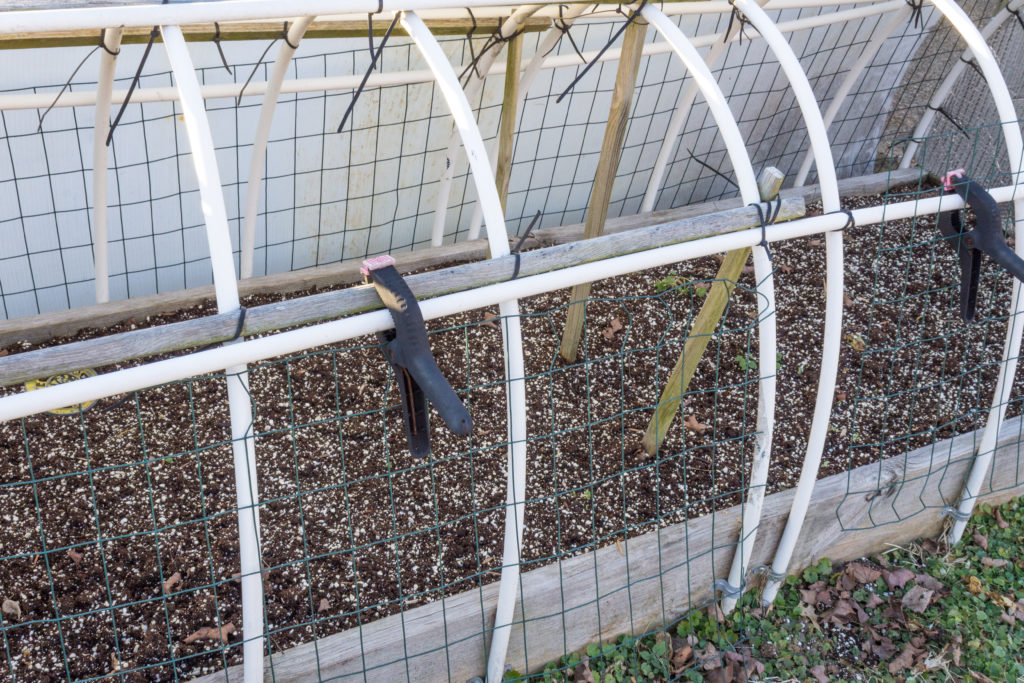
Zones 7-11 vegetable planting
- Sow in a cold frame, plastic tunnel, or beneath cloches in areas where frost may still come. Use horticultural fleece or floating cloches for early corps already in the garden if you don’t have conventional cloches.
- Direct sow hardy and half-hardy, cold-tolerant vegetables and herbs now: cabbage family members, leafy greens, and root crops: carrots, beets, cabbage, broccoli, Brussels sprouts, celery, chard, endive, parsnip, potatoes, spinach, and turnips.
- Before planting out cool-weather crops started indoors, harden off young plants from winter sowings–broccoli, cauliflower, kohlrabi, leeks, onions, lettuce, peas, and broad beans. Harden off plants by reducing the water supply or temperature.
- Make successive sowing at 10 to 14-day intervals of beets, carrots, lettuce, turnips, runner beans, green beans, endive, radishes, and kohlrabi.
- Direct sow tender warm-weather crops when the danger of frost is past and the weather is mild–plant out pole and bush snap and Lima beans, eggplants, pepper plants, casaba, celery, corn, okra, salsify, squash, cucumbers, cantaloupe, watermelons, Chinese cabbage, and black-eyed peas. Plant potatoes.
- By the end of the month, you can plant outdoor tomatoes, and tie them gently, but firmly, to stakes to secure them.
- Support young peas with sticks or netting. For sweet corn, several short rows in a rectangle will pollinate and be more successful than a few long rows.
- Celery should be fed about 3 weeks after plants are set out. Keep celery moist with regular irrigation. Blackheart celery disease is caused by alternate drying and wetting of the soil.
- Pinch out broad bean growing tips to encourage a good pod set and deter attacks from aphids.
- Stop picking asparagus so that the plants do not exhaust themselves. Prepare asparagus beds and plant asparagus crowns. In the northern regions, the first asparagus is starting to appear; cut the stems when they are 4-6 inches (10-15cm) high.
- Remove rhubarb flowers as soon as they appear, before they rob the plants of food and energy.
- Begin to thin out overcrowded vegetable seedlings. Earth up potatoes as they grow. Cover seedlings and warm-weather crops with horticultural fleece if night frost is forecast.
- Feed seedlings with manure or compost tea after planting. Soak compost or well-rotted manure in water. You can use the resulting “tea” as a liquid fertilizer. Celery should be fed about 3 weeks after plants are set out. Keep celery moist with regular irrigation. Blackheart celery disease is caused by alternate drying and wetting of the soil.
- Water garden if weather is dry. Weed as needed. Turn the compost pile.
- Watch for pests and signs of disease. Watch out for aphids on broad beans and root flies on cabbages, carrots, and onions. Pinch out the tips on broad beans to encourage a good pod set and deter attacks from aphids. Remove rhubarb flowers as soon as they appear, before they rob the plants of food and energy. Water garden if weather is dry. Weed as needed. Turn the compost pile.
Zones 7-11 herb garden
- Sow seed or set out transplants of sweet bay, hyssop, lavender, mint, rosemary, rue, and sage. Make further sowings of dill, fennel, parsley, and pot marjoram. Sow basil under glass. Propagate thyme by layering creeping stems and severing them when the roots have developed.
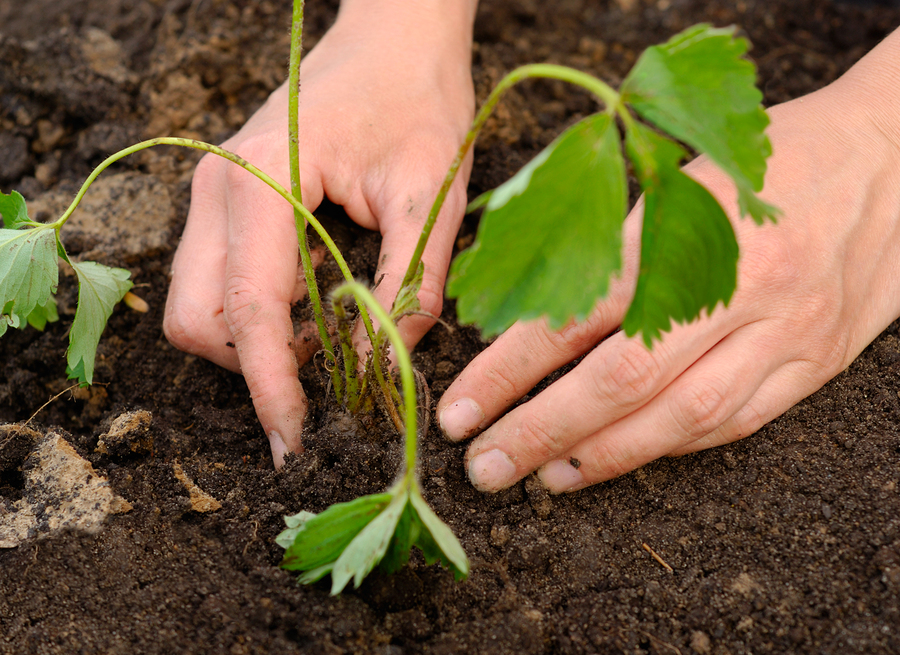
Zones 7-11 fruit trees and berries
- Set out strawberry bare roots or seedlings. Remove flowers from newly planted strawberries to prevent fruiting in their first year. Pinch off runners on new strawberry plants. Put cloches over strawberries in frosty regions if you want an early corp. Allow access for bees. Cover berries with netting to keep away birds.
- Tie new canes of blackberries and hybrid berries to support wires. Allow a maximum of eight canes per plant. Summer-prune gooseberries by cutting back side shoots to five leaves. Fasten grape stems to training wires.
- Thin new fruit on citrus, apple, and peach trees. Thin heavy-cropping nectarines and peaches when the fruit is ½ in (1-1.5 cm) in diameter. Protect open flowers from frost damage by draping muslin or horticultural fleece over trees at night. Mist open peach flowers with a fine spray to help the setting of fruit.
- Prune fruit trees cutting out crossing branches. On fan-trained apples, cherries, peaches, and plums remove branches growing towards or away from the wall.
- Check for pests and diseases. Watch for signs of fire blight; prune affected branches and dispose of them. Watch for borers and caterpillars on trees. Hang codling moth traps on apple trees. Spray against apple scab, mildew, and aphids.
- Spray against pests and disease when the buds burst or after the flower petals fall, but never on open flowers. Fruit trees and bushes should not be sprayed with insecticides while the flowers are open or the bees are working. Use sprays at dusk to avoid harming pollinating insects.
- Check tree ties on newly planted trees. Water newly planted trees and bushes during prolonged dry weather.
- Protect open flowers from frost damage by draping muslin or horticultural fleece over trees at night.
Zones 7-11 greenhouse and cold frame
- Plant greenhouse tomato plants in large pots, or plant them in grow bags.
- Water and feed greenhouse tomatoes, cucumbers, and peppers, never letting the soil dry out.
- Attach slings or nets to melons as they swell.
- Continue to remove side shoots from tomatoes.
- Use biological pest control for greenhouse pests such as greenhouse whiteflies and spider mites.
- Ventilate the greenhouse and cold frame on mild days.
Warm regions to-do list
Here is a vegetable and fruit planting guide for warm regions for the month of April and a food garden checklist.
In the United States, late frost and possible weather extremes including hot weather may occur this month in all or part of the states in the Gulf and South Atlantic Coasts, parts of the Pacific Southwest and Desert, and along the Pacific Coast. These regions include the U.S. Department of Agriculture Plant Hardiness Zones 9 and 10.
- Vegetables: Continue to sow in cold frames or beneath cloches in areas where frost may still come. Use horticultural fleece or floating cloches for early corps if you don’t have conventional cloches.
- Direct-sow or plant out successions of cold-tolerant vegetables and herbs. Plant out tender warm-weather crops when the danger of frost is past. Harden off young plants from winter sowings in the greenhouse or cold frame–broccoli, cauliflower, kohlrabi, leeks, onions, lettuce, peas, and broad beans–before planting out. Harden off plants by reducing water supply or temperature, or both. Plant out vegetable seedlings such as cabbages, celery, tomatoes, marrows, and squashes when the danger of frost is past.
- Also—when the danger of frost is past and the weather is mild—plant out pole and bush snap and lima beans, tomato plants, eggplants, pepper plants, casaba, celery, corn, okra, salsify, squash, cucumbers, cantaloupe, watermelons, Chinese cabbage, and crowder peas. Plant potatoes.
- Make successive sowing at 10-14 day intervals of beets, carrots, lettuce, turnips, runner beans, green beans, endive, radishes, and kohlrabi.
- For sweet corn, several short rows in a rectangle are better than a few long rows. Irrigation improves size and quality. Earworm damage can be cut by dusting silks every 3 to 5 days.
- Celery should be fed about 3 weeks after plants are set out. Keep celery moist with regular irrigations. Blackheart celery disease is caused by alternate drying and wetting of the soil.
- Thin seedlings of earlier plantings.
- Pinch out the tips on broad beans to encourage a good pod set and to deter attack from aphids.
- Plant outdoor tomatoes, and tie them gently, but firmly, to stakes to secure them. Support peas with sticks or netting.
- Stop picking asparagus so that the plants do not exhaust themselves. Prepare asparagus beds and plant asparagus crowns. In the northern regions, the first asparagus is starting to appear; cut the stems when they are 4-6 inches high.
- Remove rhubarb flowers as soon as they appear, before they rob the plants of food and energy.
- Thin out overcrowded vegetable seedlings are sown last month. Earth up potatoes as they grow; cover the leaves with fleece, straw, or newspaper if night frost is forecast.
- Apply manures and fertilizers where appropriate. Feed seedlings with liquid fertilizer after planting.
- Water garden if weather is dry. Weed as needed. Turn the compost pile.
- Watch for pests and signs of disease. Watch out for aphids on broad beans and root flies on cabbages, carrots, and onions.
- Herbs: Plant out bay, hyssop, lavender, mint, rosemary, rue, and sage. Make further sowings of dill, fennel, parsley, and pot marjoram. Sow basil under glass. Layer creeping stems of thyme and sever when the roots have developed.
- Fruit trees and berries: Apply fertilizer to fruit bushes if they need it.
- Tie new canes of blackberries and hybrid berries to support wires, allowing a maximum of eight canes per plant.
- Summer-prune gooseberries by cutting back side shoots to five leaves.
- Spray raspberries against raspberry beetles. Apply the first spray as soon as the first fruit turns pink.
- Fasten grape stems to training wires.
- Plant new strawberries. Remove flowers from newly planted strawberries to prevent fruiting in their first year. Pinch off runners on new strawberry plants. Put cloches over strawberries if you want an early corp. When the weather is fine ventilate strawberries under cloches to prevent leggy growth and pest build-up and to allow access for bees.
- Cover berries with netting to keep away birds.
- Thin citrus fruit, apples, and peaches.
- Check tree ties on newly planted trees. Water newly planted trees and bushes during prolonged dry weather.
- Spray against pests and disease when the buds burst or after the flower petals fall, but never on open flowers. Fruit trees and bushes should not be sprayed with insecticides while the flowers are open or the bees are working. Use sprays at dusk to avoid harming pollinating insects.
- Hang coddling moth traps on apple trees. Spray against apple scab, mildew, and aphids.
- Protect open flowers from frost damage by draping muslin or horticultural fleece over trees at night.
- Prune fruit trees cutting out crossing branches.
- On fan-trained cherries, peaches, and plums, remove branches growing towards or away from the wall.
- Mist open peach flowers with a fine spray to help the setting of fruit.
- Thin heavy-cropping nectarines and peaches when the fruit is ½ in (1-1.5 cm) in diameter.
- Check for pests and diseases. Watch for signs of fire blight; prune affected branches and dispose of them. Watch for borers and caterpillars on trees.
- Greenhouse and cold frame: Plant greenhouse tomato plants in large pots, or plant them in grow bags. Water and feed tomatoes, cucumbers, and peppers, never letting the soil dry out.
- Attach slings or nets to melons as they swell. Continue to remove side shoots from tomatoes.
- Use biological pest control for greenhouse pests such as greenhouse whiteflies and spider mites.
- Open frame on mild days.
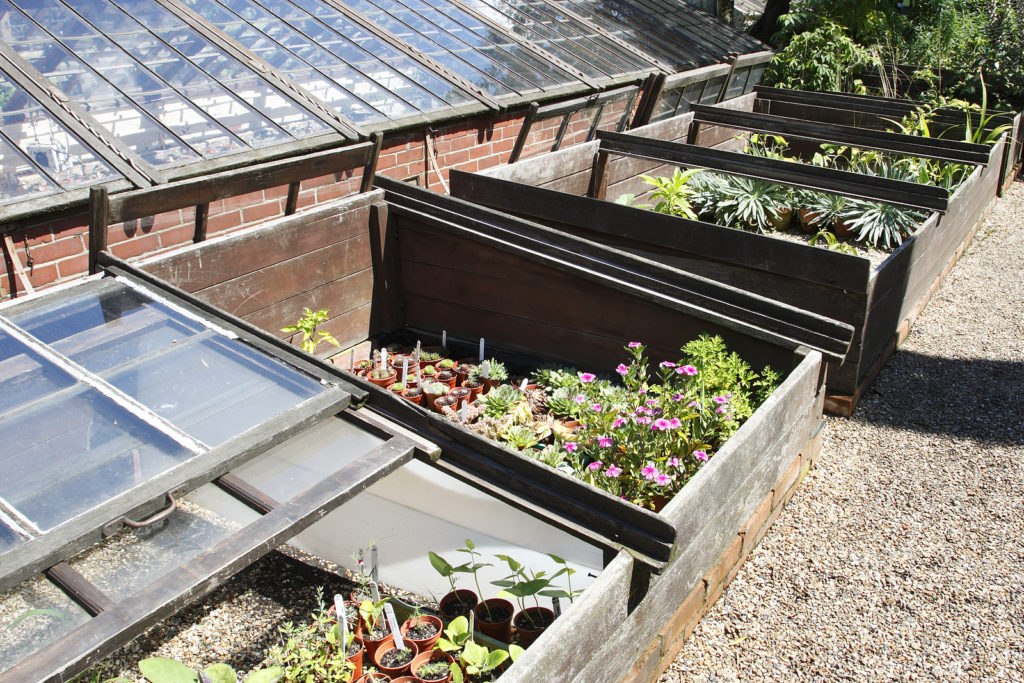
Zones 3-6 Vegetable garden checklist
In cool- and cold-winter regions, the danger of freezing weather and frost continues through April in USDA Plant Hardiness Zones 6, 5, 4, and 3. Here is a checklist of things to do in the vegetable garden in cool and cold regions during April in the Northern Hemisphere:
(USDA Zones 6, 5, 4, and 3 are the northern and coldest winter regions of the United States the northern parts of the Rocky Mountains, the northern Plains and the Midwest States, and the northern regions of the Northeast and into Canada. Temperature lows in the coldest of these regions can drop as low as -40°F (-40°C). Eastern Europe is largely in Zone 6 and Zone 5.)
Zones 3-6 cold frame and greenhouse
- In northern regions, remove heavy mulch from around plants overwintered in the cold frame.
- Open the frame when temperatures are above freezing.
- Hardy and half-hardy vegetable-starts sowed last month indoors and should be ready for the cold frame now.
- Sow cool-weather crops in the frame or beneath a plastic tunnel or cloches. Broccoli, cabbage, cauliflower, lettuce, peas, radishes, and spinach will grow in the cold frame now.
- Harden off plants started indoors or in the cold frame before moving them into the garden later.
- If the weather remains chilly in your region, sow tender summer vegetables and herbs indoors or in a greenhouse or heated cold frame at the end of this month.
- Start the seeds of summer vegetables that require 8 weeks or more indoors. Warm-weather summer crops include basil, cucumber, eggplant, peppers, squash, and tomatoes.
- Thin seedlings that have grown to size, pot them up and place them in the cold frame or plant them out later this month.
- Ventilate the greenhouse and cold frame when the outside temperature rises above 40ºF (4ºC). Close again before sundown. Ventilation should be increased on warm days as much as possible to prevent the buildup of diseases in the damp atmosphere.
- Check plants for signs of pests and disease, which often begin to multiply rapidly as the temperatures rise. Water seedlings and plants as needed.
- Make sure plants started indoors receive plenty of light.
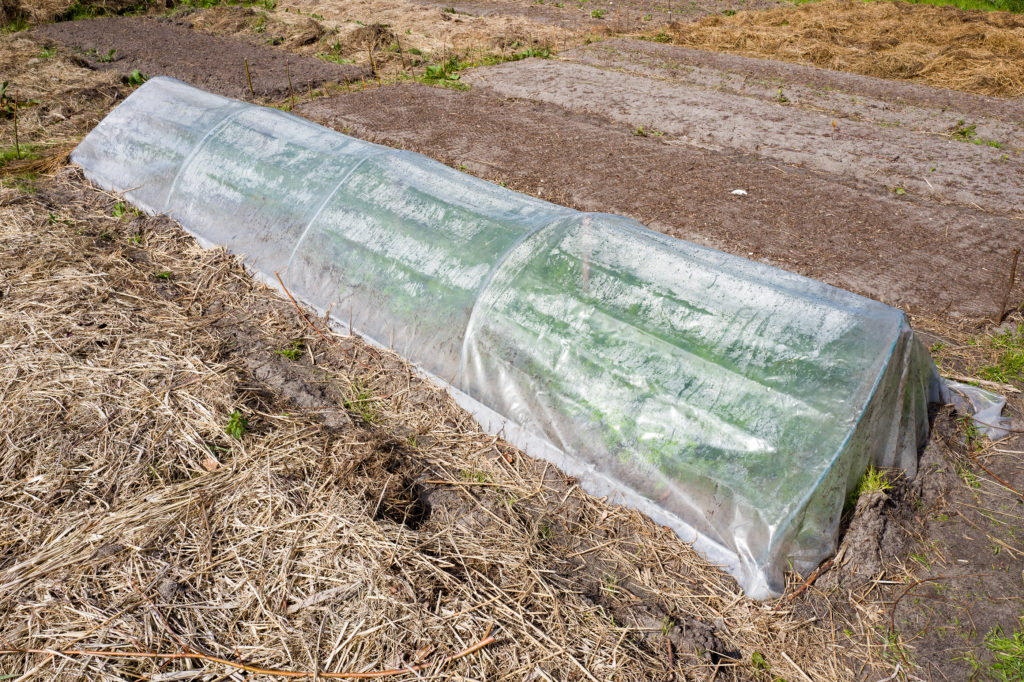
Zones 3-6 vegetable planting
- Few seeds will germinate if the soil temperature is colder than 45ºF (7ºC). Delay planting outdoors if the soil is still cold.
- Start crops in the garden under the protection of a plastic tunnel if the soil is still chilly.
- Plant out spring vegetables when heavy frost is over. Early in the month, plant onions, scallions, radishes, peas, early turnips, lettuce, spinach, and Swiss chard. Sow early peas in a sheltered spot.
- Protect cabbage, lettuce, and other vulnerable vegetables in the garden with cloches, hot caps, plastic tunnels, or inverted flower pots if the nights are expected to get cold.
- By mid-month set out seedlings of cabbage, broccoli, and Brussels sprouts if the soil is not excessively wet.
- Choose a sheltered spot with moist soil, to make the first sowing of carrots, beets, and parsley.
- Seeds of beets, carrots, and parsley should be soaked for two hours in warm water before planting.
- Sow seed or set out starts of kohlrabi, leeks, onion sets, parsnips, radishes, scallions, shallots, and turnips.
- Plant lettuce, spinach, chard bok choy, kale, and broad beans when the danger of frost has passed.
- Sow early peas in a sheltered spot.
- Plant potatoes as soon as the ground is workable. Cut the tubers into 3 or 4 pieces, each with several good “eyes”, and set them in trenches, about 3 inches (7.6cm) deep and 2 to 3 feet (.6-.9m) apart.
- Get asparagus crowns in the ground now. Remember these roots need to be planted in an area set aside for their growth over several seasons. Top asparagus crowns with well-rotted compost.
- Feed perennial vegetables with aged compost and compost tea after they begin to grow. Keep the garden free of weeds. Apply summer mulch when the weather warms.
- Water in dry regions regularly and deeply. Avoid wetting the plant foliage. Protect recently planted vegetables and herbs from drying winds.
- Before slugs, snails, and pillbugs invade your leafy greens, head them off with beer traps. Where cutworms are a problem place cardboard collars around seedlings.
- Harvest cool-weather crops as soon as they are ready. Begin to harvest spears from two- and three-year-old asparagus plants this month.
- Start sowing vegetables without protection if your weather has warmed. If you are in doubt, check your soil with a soil thermometer to make sure the soil temperature has warmed to greater than 45ºF (7ºC).
Good Products for Seed Starting Success at Amazon:
- Jump Start Germination Station w/Heat Mat Tray, 72-Cell Pack, Dome
- Espoma Seed Starting Mix
- 200 Count- Jiffy 7 Peat Soil Seed Starting Plugs
- Seed Starter Kit with Humidity Dome (120 Cells Total Tray)
- AgrobriteT5 Fluorescent, 2-Foot, Grow Light System
Zones 3-6 herb garden
- Herbs can be sown in the garden when the frost has passed. Sow seeds of chervil, dill, fennel, parsley, pot marjoram, and sorrel.
- Perennial and biennial herbs can be lifted, divided, and replanted now. Look for any overgrown clumps of bergamot, chives, and fennel.
Zones 3-6 container garden
- If you garden in containers, prepare them now. Clean pots thoroughly. Move large containers outdoors and fill them with potting mix mixed with compost.
- Cold-tolerant vegetables can be planted into containers this month.
- Water container plants as needed and fertilize them with a water-soluble fertilizer such as compost tea or worm castings.
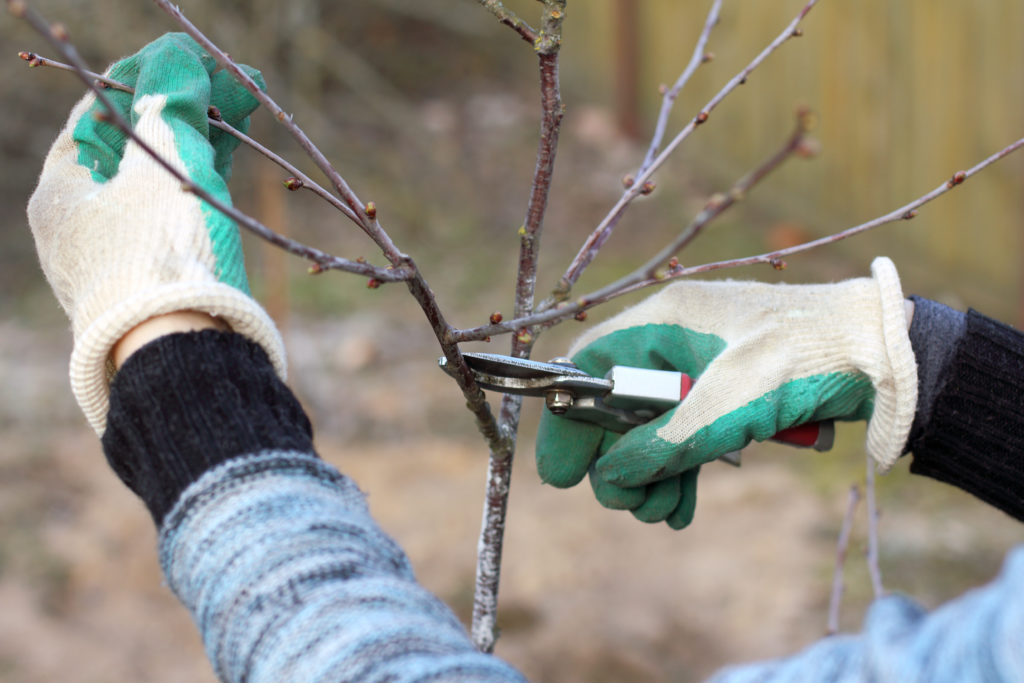
Zones 3-6 fruit trees and berries
- Spray fruit trees for over-wintering pests with dormant spray oil when the temperature rises above 45ºF (7ºC) and before buds break. Spray peaches, nectarines, apples, pears, plums, and almonds with a copper-based fungicide. As long as the buds have not broken, apply a second spray to trees in about 14 days.
- Spray peaches and nectarines with a fungicide recommended for peach leaf curl. Sprinkle sulfate of potash around the root-feeding area of apples, pears, and plums to encourage good fruiting later in the year.
- Mulch established fruit trees and bushes with garden compost or rotted manure.
- Sprinkle sulfate of potash around the root-feeding area of apples, pears, and plums to encourage good fruiting later in the year.
- Prune autumn-fruiting raspberries. Cut the canes that fruited last autumn back to ground level. Prune back canes of raspberries planted last year to about 12 inches (30cm).
- Prune back the stems of newly planted and two-year-old gooseberries by about one-half.
- Plant currant bushes and raspberry canes, and water in thoroughly.
- Spray gooseberries and black currants for gooseberry mildew.
- Protect strawberry plants with cloches.
- Fertilize strawberries, brambles, and grapevines with compost when the first blossoms show.
- Train blackberries and loganberries onto support wires.
Cool regions tasks for April
Here is a vegetable and fruit planting guide for cooler regions for the month of April and a food garden checklist.
In the United States, the danger of frost continues this month in all or part of the states in the Northeast, Mid-Atlantic, Mid-South, Pacific Northwest, Rocky Mountains, and Plains regions. These regions include the U.S. Department of Agriculture Plant Hardiness Zones 4, 5, 6, 7, and 8.
USDA zones 4, 5, and 6 range over sections of the Northeast, Rocky Mountain, and Plains states. USDA zone 7 and 8 includes portions of the Mid-South, Southwest, and Desert states, and parts of the Pacific Northwest states.
- Vegetables: Prepare soil for early planting: cover with black plastic for several sunny days, and then dig. Turn the compost pile when it thaws. Place cloches in a position to warm up the soil.
- Plant out spring vegetables when heavy frost is over. Early in the month, plant onions, scallions, radishes, peas, early turnips, lettuce, spinach, and Swiss chard. Sow early peas in a sheltered spot. Protect cabbage, lettuce, and other vulnerable vegetables with cloches, hot caps, plastic tunnels, or inverted flower pots if the nights are expected to get cold.
- A week later, plant carrots, beets, cabbage, broccoli, Brussels sprouts, celery, endive, parsnip, and potatoes. Choose a sheltered spot with moist soil, to make the first sowing of carrots. Seeds of beets, carrots, and parsley should be soaked for two hours in warm water before planting.
- At the end of the month, plant corn, beans, melon, cucumber, squash, parsley, pepper, tomato, and eggplant. Don’t set out tomato plants or warm-season crops too soon.
- Plant potatoes as soon as the ground is workable. Cut the tubers into 3 or 4 pieces, each with several good “eyes”, and set them in trenches, about 3 inches deep and 2 to 3 feet apart.
- Fruits trees and berries: Spray peaches and nectarines with a fungicide recommended for peach leaf curl. Sprinkle sulfate of potash around the root-feeding area of apples, pears, and plums to encourage good fruiting later in the year.
- Plant fruit trees when the soil is workable. Water new plantings deeply if the weather is dry. Paint white or wrap trunks of young trees to prevent sunscald.
- Mulch established fruit trees and bushes with garden compost or rotted manure.
- Plant bushes and brambles when the soil is workable. Prune autumn-fruiting raspberries. Cut back to ground level the canes that fruited last autumn. Prune back canes of raspberries planted last year to about 12 inches. Stakes brambles.
- Fertilize established berries and grapes or top-dress with compost. Water new plantings deeply if the weather is dry.
- Check for borers and caterpillars on trees; take appropriate measures.
- Cold frames: Finish sowing summer vegetables—melon and cucumbers–and tender herbs indoors early this month. Care for seedlings growing indoors. Harden off seedlings that were started in the hotbed.
- Greenhouse: Make sure the glass is clean so that the plants receive plenty of light. Increase ventilation on warm days. Ventilate as much as possible to prevent the buildup of diseases in the damp atmosphere.
Related articles:
April Seed-Starting Veggies Zone-by-Zone
Garden Planning Books at Amazon:
- Vegetable Garden Almanac & Planner
- Kitchen Garden Grower’s Guide Vegetable Encyclopedia
- Vegetable Garden Grower’s Guide
- Tomato Grower’s Answer Book

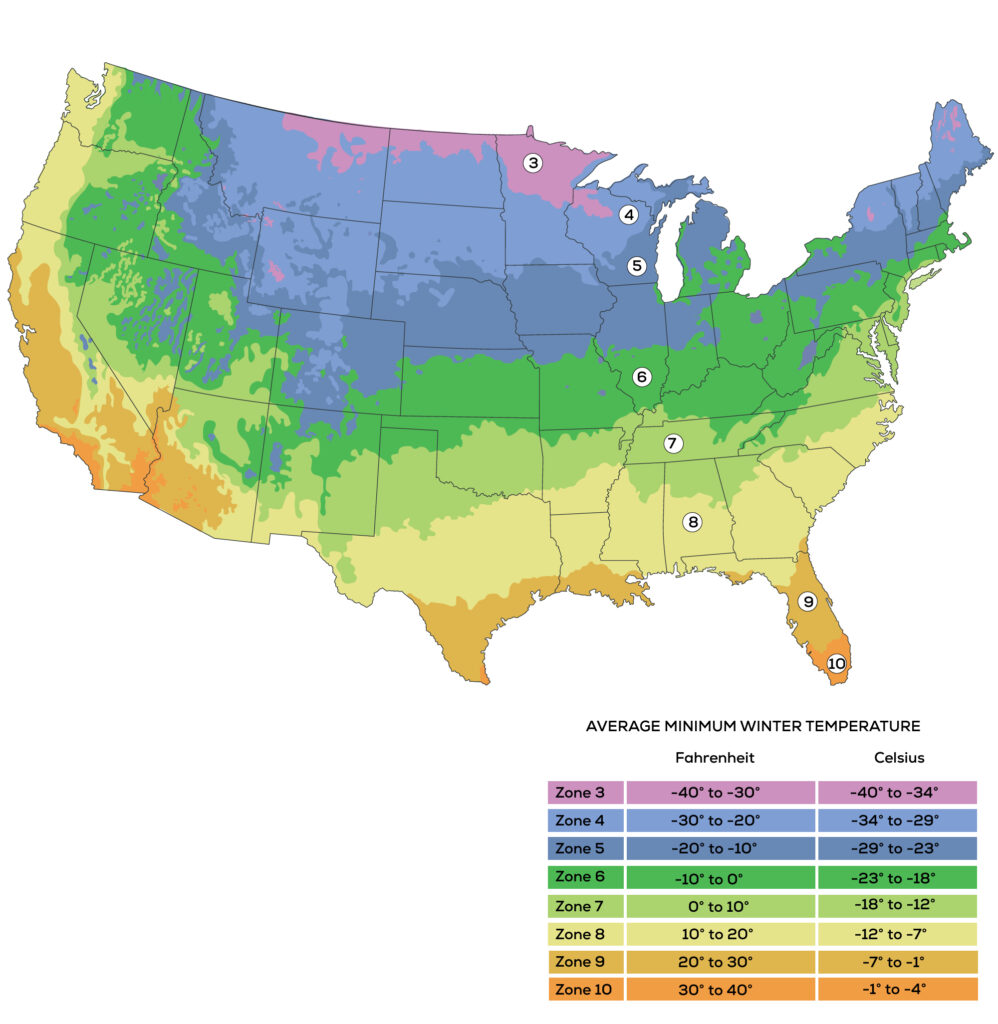 Soil preparation in warm- and cold-winter regions–all zones
Soil preparation in warm- and cold-winter regions–all zones

